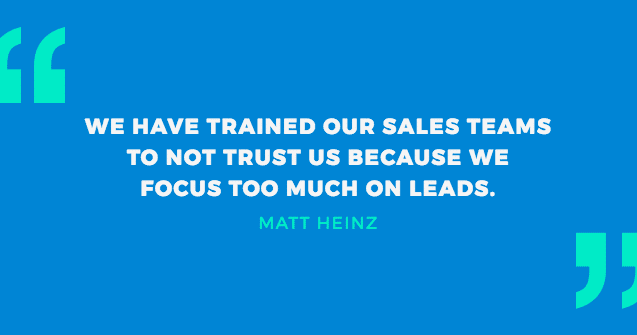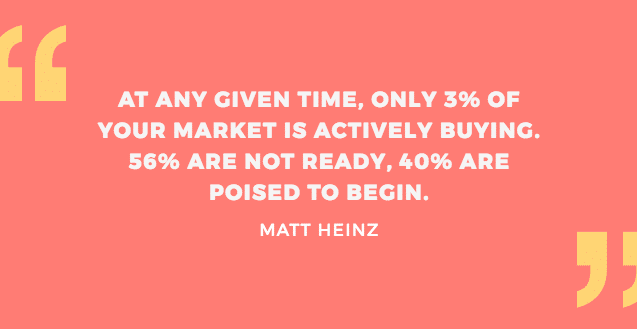Forty percent of B2B companies had a full account-based marketing (ABM) program in 2016 according to a SiriusDecisions survey. This increased to 62% in 2017 and will likely increase even more in 2018.
When 91% of marketers say deal sizes are larger for ABM accounts than they are for non-ABM accounts, it’s hard to avoid ABM. But how do you become like the five percent of marketers that say deal sizes are 200% larger for ABM accounts?
Matt Heinz, a renowned teacher of ABM strategy, has some advice.
In his quick-hitting presentation given at the #FlipMyFunnel conference (iTunes, Spotify), Heinz told attendees how to maximize the impact of ABM campaigns with sales and marketing alignment and good data.
In this post, I highlight his best advice and provide direction and tools to help you take action on the strategies he presents.
Sales and Marketing Alignment
Adopt the ABM approach sales is using
Using an account-based approach is trendy for marketers but standard for sales teams.
“If you’re a marketer, you’ll look silly if you approach sales saying you have a great new idea to market to target accounts,” says Heinz. It’s better to acknowledge that sales already has a target account program and weave marketing into it.
The marketers seeing deals sizes that are 200% larger are making sales the heroes. In other words, they’re using ABM to deliver messaging and content that complements sales’ ongoing efforts to turn target accounts into customers.
“We have trained our sales teams not to trust us because we focus too much on leads,” said Heinz.


Here are some ways you can help sales nurture accounts with ABM, from top to bottom:
- Advertise to hand-picked accounts with software (we use Terminus)
- Send strategies with custom first pages via email
- Sending fully customized, printed strategies by mail
- Invite contacts to dinners and parties at events
Replacing lead-based tactics with these account-based tactics will help you bring more valuable accounts to the table. As a result, you’ll also be more focused on what matters.
So next time you celebrate a win, consider what you’ve actually won — for the company. Did marketing’s efforts result in more revenue? If not, the celebration is premature.
Have a Common Set of Definitions
Marketers that are helping sales win big deals have agreed on what the sales cycle looks like. Further, they have agreed on what each step in the sales cycle means.
At my last job, a visualization of the sales cycle, complete with definitions, was posted on the company’s walls and distributed as handbooks to employees.
Until you have time to create something like this, start by defining what a target account and marketing qualified account are. What attributes do they have? These are two of the most important terms to define.
After you define them, define goals. Start by asking the question: How many leads do we need to generate X number of opportunities to generate Y number of sales?
To figure this out, work from the bottom up:
- Find out how many sales you need. Divide your revenue goal by your average deal size.
- Calculate your close rate. Divide the number of sales qualified opportunities for the number of sales. Multiply by 100.
- Calculate pipeline goal. Multiply your revenue goal by the inverse of your close rate.
- Find out how many opportunities you need. Then divide your pipeline goal by your average deal size.
- Find out how many leads you need. Calculate your lead-to-opp conversion rate. Then multiply the inverse of this times the number of opportunities you need.
“This is math. Don’t make it more complicated,” says Heinz.
Data as a Sales and Marketing Tool
Work with clean data
Clean data is the greatest sales enablement that marketing can offer, Heinz says. However, most companies don’t have a regular, systematic way of updating their data.
B2B databases decay at a rate of two to four percent per month which is a serious problem. At the very least, Heinz says you need to execute a data hygiene plan biannually.
Some parts of this plan may include:
- Verifying data within your marketing automation platform and CRM is the same for each contact. (Ensure that Marketo is enriching contacts with the same data as Salesforce is.)
- Deduplicating contacts and accounts. (Ensure that there’s only one contact record for an individual person and one account record for an individual company, especially for high-value prospects and customers.)
- Experimenting with new data enrichment tools. (If you’re experiencing too many errors with your current data enrichment tools, test new ones and inquire about data accuracy.)
Without a plan, you risk sending emails that go nowhere, making calls that go nowhere, qualifying the wrong accounts, and ultimately wasting time.
Use data for B2B buying signals
Use good data for more than outreach and account qualification. When paired with the right platform, data can alert you when prospects are ready to buy solutions like yours.
“It would be nice if the CIO went on Twitter and said ‘I need product X to solve Y,’ but this doesn’t happen,” says Heinz. You need to identify buying signals that are more nuanced.


Sales and marketing Intelligence tools can help you with this.
For instance, at Intricately we alert cloud service providers when their target accounts start spending less on competitors. A decrease in spending indicates a decrease in usage, which means the account may be experimenting with other providers.
You can use other intelligence platforms to collect B2B buying signals, too:
- Bombora: Alerts you when target accounts start researching your product and related products online
- Crunchbase Pro: Alerts you when target accounts receive new funding, leadership, and acquisitions.
- Leadgnome: Alerts you when decision-makers within customer and target accounts leave a company
As a marketer, you can use buying signals provided by these tools to nurture leads with the right content at the right time. Consequently, as a sales pro, you can use them to ask better questions and have more meaningful conversations with prospects.
More Advice for Bigger Deal Sizes
Matt’s presentation covers more than just alignment and data are just some of the topics. He also talks about content relevance, productivity, and sales tactics that support an account-based approach.
Here are some of my favorite takeaways:
- Make Sales the leaders. Marketing doesn’t mean anything unless it can be attributed to new revenue.
- Don’t have sales create content. This hurts productivity. Salespeople should sell and marketing should create content.
- If you’re a marketer, sit alongside the sales team to see what kinds of conversations they’re having with prospects. This should inform what kind of content you create.
- If you create new messaging as a marketer, teach sales about what that messaging means. Practice with sales how to use it in pitches.
- Don’t treat target accounts like other accounts. For instance, don’t speak with a prospect of a target account at a trade show and then send them a dull email from a drip campaign.
- Tell prospects about a real problem they have before they even have it. (Sales and marketing intelligence tools are good for this.)
Take action on one piece of advice Heinz offers and you’ll get one step closer to bring better accounts to the table. Rather than being one of the many companies doing ABM, you’ll become one of the few doing it right.
Robert Gibb is a writer and marketer for B2B tech startups. He’s currently helping Intricately grow its intelligence platform that shows cloud teams how companies are using other cloud-based services. He covers strategic ABM for B2B companies in this piece for Crunchbase.






